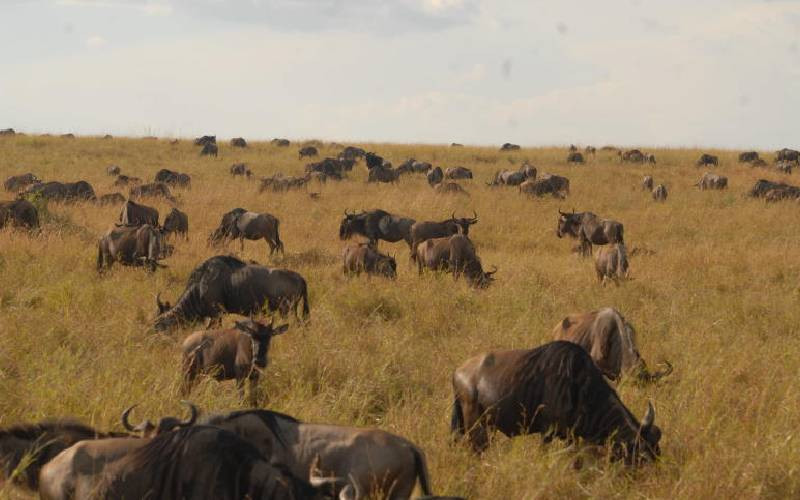Mercy Langat draws water from the small pool to fill her bucket on a nearly dry riverbed near Silibwet in Bomet County.
The dry rocks in Kapsasurwa stream are the picture of a perennial spring that has dried due to prolonged drought. The stream that rises from this valley is one of the many tributaries of River Nyangores, which further downstream joins River Amala to form the Mara River – the water body that sustains life in the Masai Mara and Serengeti game reserves.
“Water has gradually been depleted since January and now the spring is totally dry and we can only get some water early in the morning,” says Langat.
The Kenya Meteorological Department warns this is one of the visible results of the delayed rainy season and increased pressure on the Mau Forest Complex.
Benard Chanzu of the Met Department warns that this phenomenon is more likely to recur due to climate change.
“In the past while temperatures would rise, it would be for a day or two but not like for a whole month or two as has been seen this year,” says Chanzu, warning that storms are also becoming more frequent than before.
As Langat lumbers up the steep slope with a water bucket on her head, it is not difficult to notice the stark difference in vegetation on both sides of the valley.
On one side are indigenous trees forming a canopy over the valley while on the opposite side are blue gum trees planted mainly for commercial purposes.
Paul arap Sang, a resident, says this is part of the problem, other than increased destruction in the Mau ecosystem. Blue gum trees consume a lot of water and deplete wetlands.
“We have tried to talk to our neighbours to plant indigenous trees and cut down these eucalyptus but they have refused, now we are requesting the government to come up with a law that bans planting of these trees near the water sources,” Sang says.
Due to evaporation
He has adopted smart farming, where he has tea plantation on one section parallel to the valley, avocado trees on another and oleander for his dairy cows and goats, while Napier grass rows serve to prevent soil erosion. He has allowed a 10-metre buffer zone between the farm and the river – this is where he has planted 250 trees.
“This stream has never dried up since and we believe it is the destruction of vegetation cover that has led to the current situation,” Sang says.
Chanzu however says that permanent streams have become seasonal while some have disappeared completely due to evaporation from the ground.
This has led to less surface water, which flows as streams. He says this is one of the reasons some parts of Kenya are receiving erratic rainfall.
Stay informed. Subscribe to our newsletter
Downstream at the bridge on Silibwet-Olenguruone road, the story is not any different.
David Kirui loads eight 20-litre jerrycans on his motorbike. He has been doing brisk business over the past two months even as the waters receded. Bare rocks tell the story of a river that is at its worst.
You can actually cross the river by stepping on exposed boulders, a far cry from a river that bubbles downstream and runs in to Lake Victoria hundreds of kilometres away at Musoma in Tanzania.
“We sell each jerrycan at Sh20 shillings but when it starts to rain, we shall have to re-strategise because there will be water and tanks will be full,” Kirui says.
Tenwek Hospital, one of the biggest health facilities serving the South Rift region, is bearing the brunt of a thin river. The hospital produces its own electricity from a dam built across Nyangores River.
Sources at the hospital say they have resorted to using generators and power from Kenya Power for their energy needs as the water cannot turn the turbines anymore.
 The Standard Group Plc is a
multi-media organization with investments in media platforms spanning newspaper
print operations, television, radio broadcasting, digital and online services. The
Standard Group is recognized as a leading multi-media house in Kenya with a key
influence in matters of national and international interest.
The Standard Group Plc is a
multi-media organization with investments in media platforms spanning newspaper
print operations, television, radio broadcasting, digital and online services. The
Standard Group is recognized as a leading multi-media house in Kenya with a key
influence in matters of national and international interest.
 The Standard Group Plc is a
multi-media organization with investments in media platforms spanning newspaper
print operations, television, radio broadcasting, digital and online services. The
Standard Group is recognized as a leading multi-media house in Kenya with a key
influence in matters of national and international interest.
The Standard Group Plc is a
multi-media organization with investments in media platforms spanning newspaper
print operations, television, radio broadcasting, digital and online services. The
Standard Group is recognized as a leading multi-media house in Kenya with a key
influence in matters of national and international interest.









